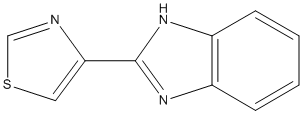All AbMole products are for research use only, cannot be used for human consumption.

Thiabendazole inhibites the mitochondrial helminth-specific enzyme, fumarate reductase, with possible interaction with endogenous quinone.A benzimidazole derivative with anthelminthic property. Thiabendazole inhibits the helminth-specific mitochondrial enzyme fumarate reductase, thereby inhibiting the citric acid cycle, mitochondrial respiration and subsequent production of ATP, ultimately leading to helminth’s death.
| Molecular Weight | 201.25 |
| Formula | C10H7N3S |
| CAS Number | 148-79-8 |
| Form | Solid |
| Solubility (25°C) | DMSO 30 mg/mL |
| Storage |
Powder -20°C 3 years ; 4°C 2 years In solvent -80°C 6 months ; -20°C 1 month |
[5] H J Robinson, et al. Thiabendazole: toxicological, pharmacological and antifungal properties
| Related Mitochondrial Related Products |
|---|
| Mito-Lonidamine
Mito-Lonidamine (Mito-LND) is an orally active and mitochondria-targeted inhibitor of oxidative phosphorylation (OXPHOS). Mito-Lonidamine inhibits mitochondrial bioenergetics, stimulates the formation of reactive oxygen species, and induces autophagic cell death in lung cancer cells. |
| OPC-163493
OPC-163493 is an orally active and liver-targeted mitochondrial uncoupling agent. OPC-163493 reduces the production of mitochondrial Δψ and ROS. |
| Mitochondrial fusion promoter M1
Mitochondrial fusion promoter M1 is a mitochondrial dynamic modulator. Mitochondrial fusion promoter M1 preserves the mitochondrial function and promotes cellular respiration. Mitochondrial fusion promoter M1 (2 mg/kg; iv) alleviates cardiac and brain damage in rats with cardiac ischemia/reperfusion injury. |
| NL-1
NL-1 is a mitoNEET inhibitor with antileukemic effect. NL-1 inhibits REH and REH/Ara-C cells growth with IC50 values of 47.35 μM and 56.26 μM, respectively. |
| Malonyl CoA lithium
Malonyl CoA lithium is an inhibitor of carnitine palmitoyl transferase 1 (CPT1). Malonyl Coenzyme A lithium (Malonyl CoA lithium) is an important precursor for the production of a variety of chemicals that modulate insulin-stimulated glucose transport in myotubes. Malonyl Coenzyme A is a coenzyme A derivative that is utilized in fatty acid and polyketide synthesis and in the transport of α-ketoglutarate across the mitochondrial membrane. |
All AbMole products are for research use only, cannot be used for human consumption or veterinary use. We do not provide products or services to individuals. Please comply with the intended use and do not use AbMole products for any other purpose.


Products are for research use only. Not for human use. We do not sell to patients.
© Copyright 2010-2024 AbMole BioScience. All Rights Reserved.
